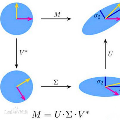This paper tackles optimal sensor placement for Bayesian linear inverse problems, a popular version of the more general Optimal Experiment Design (OED) problem, using the D-optimality criterion. This is done by establishing connections between sensor placement and Column Subset Selection Problem (CSSP), which is a well-studied problem in Numerical Linear Algebra (NLA). In particular, we use the Golub-Klema-Stewart (GKS) approach which involves computing the truncated Singular Value Decomposition (SVD) followed by a pivoted QR factorization on the right singular vectors. The algorithms are further accelerated by using randomization to compute the low-rank approximation as well as for sampling the indices. The resulting algorithms are robust, computationally efficient, require virtually no parameter tuning, and come with strong theoretical guarantees. We also propose a new approach for OED, called reweighted sensors, that selects $k$ sensors but judiciously recombines sensor information to dramatically improve the D-optimality criterion. Additionally, we develop a method for data completion without solving the inverse problem. Numerical experiments on model inverse problems involving the heat equation and seismic tomography in two spatial dimensions demonstrate the performance of our approaches.
翻译:暂无翻译




